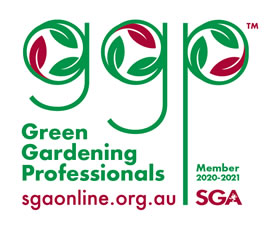| item(s), Total: $0.00 View Cart |
| Shopping cart is empty. |
Happy New Year, Green Lifers! We trust everyone had a little chance to relax over Christmas. The weather made it less conducive to get garden projects done - many plants have fried in the heatwave conditions we've had and I know how disheartening it is. Unfortunately the next month or so won't be a lot better - the height of summer means survival mode for most gardens. If you've managed to keep things thriving, you're doing well. We spend much of the Christmas period indoors trying to stay cool - sometimes a forced rest isn't a bad thing. Paul delved deeply into researching - if any of you are into Korean Natural Farming methods (or IMO - indigenous micro-organisms) I'm sure Paul would be happy to have a chat... I'm sure it won't be long before we've got buckets of all sorts of fermented stuff around as he experiments. We've already got some new & exciting amendments to our mixes coming soon - more on that next month! Hopefully we've got some interesting tips & advice for you in this newsletter. Feel free to let us know if you have suggestions for future topics. Remember that we have all previous newsletters available on line (see the 'newsletter' tab) for you to read through; plus lots of other fact sheets available (pages & pages worth) under the 'learn' tab. If you're stuck indoors grab a cool beverage and take some time to have a look through. It's all free! In this newsletter we've got articles on:
Jobs for the January Garden
What to Plant NOWIt's the hottest time of the year in Perth making gardening extra challenging. Remember we've got 50% and 70% white horticultural shadecloth in stock - so get some protection up for your vegie patch and with a daily hand water you'll still be able to have a productive garden. Now's the time of year for some succession planting, time to think about starting winter brassicas from seed* (well, almost!), and time to think about your Autumn/Winter garden and what is going to follow on from your summer crops when they run out of steam.
* Remember that Brassica vegetables (Brussel sprouts, cabbage, cauliflower, broccoli, kale, kohl rabi) are best grown as Winter crops here in Perth. While they will grow in Summer, they are more susceptible to pests like Cabbage Moth & Cabbage Butterfly, so it's best to keep them under insect netting at this time of year. Keep up the water as stressed plants will bolt to seed, and ensure seeds & seedlings aren't allowed to dry out. Brussel Sprouts are borderline in Perth - they thrive in cold weather; and usually our Perth Winters are too mild for them. Brussel Sprouts and Cauliflower are slow to produce - so for your best chance of success, start off seeds early so that once conditions cool down in Autumn you have advanced seedlings ready to go in the ground... I think it's a little too early YET - but check on your seed stocks so you're ready in a few weeks, if you want to try. Of course - here's where it get's really tricky - you need to predict WHEN it's going to get cool enough; so starting a few seeds off every couple of weeks will be helpful. Check out our FREE downloadable 'When to Plant Guide' here - we've got one for vegies and another for herbs, in a handy month-by-month list. (You'll now need to sign in as a member to access our FREE downloads.) As Cool as a Cucumber!
Cucumis sativus - Cucumber - is an Australian staple in summer salads. There is a large range of varieties available to grow at home - not just the long "Continental Cucumbers" that come shrink wrapped in the shops. [I read recently that such shrink wrapping is being banned in other countries so I expect Australia will follow eventually.] Cucumbers are relatively easy to grow so it's definitely worth having a go. You can plant them anytime through the warmer months - obviously in 40° heat you'll need to give them a lot of TLC to get them established. Cucumbers are low in calories, cholesterol and fat free - so are a popular choice for the new year dieter!! Nutritionally they're typically 95% water, 4% carbohydrate and 1% protein; but 100% crunchy and yum! If growing from seed, once soil temperatures are warm, they'll germinate within a week (sometimes a few days). They can be started off in seedling trays - the biodegradable pots are perfect as you can then transplant them without root disturbance. Make sure the soil you plant them out into is rich - they do like a fertile soil and will need nitrogen and potassium to perform well. They don't like acidic conditions - in Perth this isn't going to be an issue for most people! (If you know you have acidic conditions add some lime prior to planting.)
Bitterness in cucumbers is produced by a substance called cucurbitacin. This is the same compound that causes burping and gas. Some varieties produce a lot less - these are marketed as "burpless cucumbers". Peeling cucumbers will reduce the amount of cucurbitacin you ingest, as it's concentrated in skin and the seeds. The compound is concentrated with less water in plant cells; so if your fruit is bitter, water a lot more. Avoid picking fruit at the end of the day (when there's likely less water in plant cells after a hot day), and pick the fruit young. It is thought that cucumbers originated in India, and there is evidence they were cultivated in Europe in Roman times - so they're one of the oldest cultivated vegies (technically a fruit). Although grown for centuries, it fell out of favour for a short time in parts of Europe in the 17th century when it was thought raw vegetables were harmful. Cucumbers were used as stockfeed and called "Cowcumbers" - which is quite cute. Thankfully they were so widely grown elsewhere that they came back into universal favour. (Excepting my brother.)
Some people are surprised to find home grown cucumbers have small spines on the skin - these are removed for commercial crops. I find a very light rub over with a plastic scourer takes the spines off easily before you use them. Homegrown cukes are best picked and used fresh. Store in a cool, dark place - the fridge is fine, but if too cold they'll turn mushy. So give growing a cucumber a go! We have a range of seed varieties & some seedlings in stock @ GLSC. Photo CompetitionThank you to everyone who's been sending in photos of their gardens recently - keep them coming! I choose a winner at random each month to win a $50 store credit - you've got to be in it to win it - so it might as well be YOU! You can either email in your pics or message via FB - with the title "Photo comp" and a few words about what you're growing, or about your garden generally. It always inspires others to see what can be done; we've seen some very clever ideas indeed. This month, I'd like to congratulate Brian & Angela for sending in these photos of their wicking beds. It goes to show that even with weather conditions like we've had, vegetables can still thrive if established and they're cared for. Wicking beds make the difference as they ensure plants can take up water as and when they need it. They're quite sensible in our climate. (If you'd like more information on setting up a wicking bed, we have a fact sheet & downloadable diagram on our website). Brian and Angela are in Ashby, and are really pleased with how the wicking beds are sustaining their corn & pumpkin plants.
VIP SpecialThere's changes afoot to the Member's/VIP section on our website. Since migrating the site to a new platform late last year, there's definitely been some glitches; among them the fact that most of the specially priced VIP specials had disappeared from the website! We've now fixed this & will be more regularly updating and bringing in time sensitive specials to the Members Only log in section - so do check in regularly. All of our special downloadable guides will now be accessed via the Member's section too - so if you're looking for our 'When to Plant' guide our our popular 'Top 12 edible plants for Autumn/Winter' (or Spring/Summer) - you'll need to sign in to access them. Many of our other fact sheets are still accessible from the 'Learn' tab - it's just the downloadable guides that have been moved. Also - if you had a log-in previously, you'll need to reset your password now that the hosting platform has changed. This is for user security and unfortunately we were unable to work around this step - passwords are never accessible to us so we're unable to "move" them across. Because we know getting water into your soil - and keeping it there - is such an issue for many right now, we've got a VIP special on for Sand Remedy. This is a mineral mix we make in house. It has a bentonite base, to which we add a number of other important minerals which combine to assist with water and nutrient holding. It helps water penetrate, and keeps it at the root zone where it's needed by your plants. It contains trace elements, and also makes other fertilisers more effective, preventing leaching. Sand Remedy goes a long way - a 5kg tub will treat about 15m2.
A 5kg tub is normally $32 & a 20kg tub is normally $85. This month, until COB February 5th 2022, VIP pricing on the tubs is TRADE PRICE - ie. 5kg = $25 (save $7) & 20kg = $68 (save $17). VIP price is valid in store & online - log into the member's section to find your member's only pricing on Sand Remedy (and much more besides!). In store or phone orders - please ask your GLSC team member to apply the special price for you. Return & Refill - because we make Sand Remedy in house, you can bring your own tubs in for a refill and SAVE even more - pay per kg, and save plastic packaging! Retailer Update
Beaufort Garden World - Inglewood 9271 0585 (stock pictured; right)
THANK YOU for being part of The Green Life Family! Keep up to date with news & info on our Facebook and Instagram pages. Until next time - Happy Gardening! |

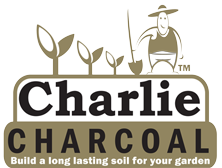

 It's hard to believe, but this January marks TWO YEARS that we have been at our 'new' premises. What an interesting two years it's been for everyone - who could have anticipated the changes that we've faced in that time. 2022 is looking to be a rollercoaster too - while I know some are very anxious to reunite with friends and family; others are anxious with regard to the opening up of the State in weeks to come. At times like this, our gardens are our sanctuary. If we can grow a little bit of our own food, it helps too! At GLSC we really believe gardens are vital for our physical and mental health. While I know this is a very divisive issue, GLSC are complying with current Government mandates for retailers, and all of our front line staff are fully vaccinated. We have no plans in place to restrict customer access, but while the mask & check-in obligations remain we do ask you respect our team if they ask you to do either. We have elderly and immuno-compromised customers who are deeply concerned, and we need to ensure that all customers have a safe shopping experience with us, and appreciate your co-operation. Remember that you can arrange contactless click & collect pickup or delivery at any time if you wish to restrict your own exposure. [update 7.1.22 - from 6pm tonight masks no longer required! yay!]
It's hard to believe, but this January marks TWO YEARS that we have been at our 'new' premises. What an interesting two years it's been for everyone - who could have anticipated the changes that we've faced in that time. 2022 is looking to be a rollercoaster too - while I know some are very anxious to reunite with friends and family; others are anxious with regard to the opening up of the State in weeks to come. At times like this, our gardens are our sanctuary. If we can grow a little bit of our own food, it helps too! At GLSC we really believe gardens are vital for our physical and mental health. While I know this is a very divisive issue, GLSC are complying with current Government mandates for retailers, and all of our front line staff are fully vaccinated. We have no plans in place to restrict customer access, but while the mask & check-in obligations remain we do ask you respect our team if they ask you to do either. We have elderly and immuno-compromised customers who are deeply concerned, and we need to ensure that all customers have a safe shopping experience with us, and appreciate your co-operation. Remember that you can arrange contactless click & collect pickup or delivery at any time if you wish to restrict your own exposure. [update 7.1.22 - from 6pm tonight masks no longer required! yay!] Jobs to do in the January garden
Jobs to do in the January garden Make sure YOU take care in the heat - slip, slop slap, and work in the cool of the morning or evening to avoid over-doing it in the heat of the day. Stay hydrated and take regular breaks.
Make sure YOU take care in the heat - slip, slop slap, and work in the cool of the morning or evening to avoid over-doing it in the heat of the day. Stay hydrated and take regular breaks.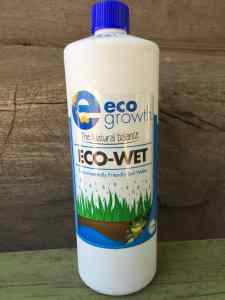 Use a soil wetter. These are a temporary fix - it's better to incorporate clay and/or biochar or Mineral Magic into the soil for a permanent solution. But in the height of summer, particularly in existing garden beds where you don't want to disturb roots, a soil wetter will help in the short term and be a lifeline for your plants. Use a good quality soil wetter (
Use a soil wetter. These are a temporary fix - it's better to incorporate clay and/or biochar or Mineral Magic into the soil for a permanent solution. But in the height of summer, particularly in existing garden beds where you don't want to disturb roots, a soil wetter will help in the short term and be a lifeline for your plants. Use a good quality soil wetter (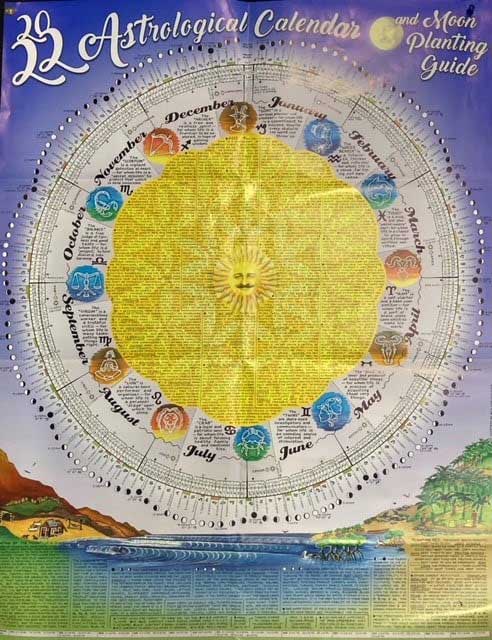 Check out your seed stock of autumn/winter growing vegies. Make a list of what is still viable, and what you will need to buy in fresh. Make a note of what crops you are growing now and read up on Crop Rotation - where are you going to plant your next round of vegies?
Check out your seed stock of autumn/winter growing vegies. Make a list of what is still viable, and what you will need to buy in fresh. Make a note of what crops you are growing now and read up on Crop Rotation - where are you going to plant your next round of vegies?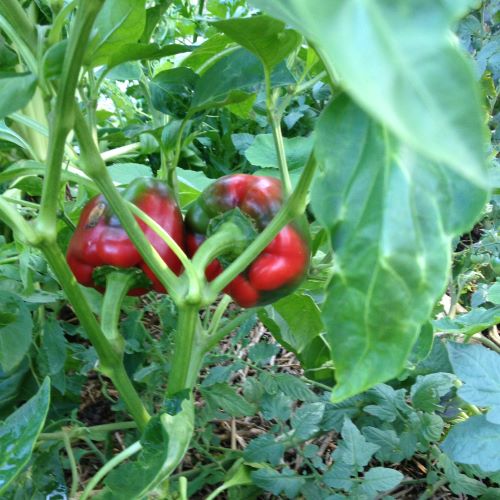 Plants to consider growing now include: Basil, Beans (snake beans highly recommended for summer), Beetroot, Capsicum (pictured right), Chilli, Carrots, Chokos, Cucumber, Eggplant, Ginger, Leeks, Lettuce, Malabar Spinach, Okra, Parsnips, Pumpkin, Radish, Rockmelon, Rosella, Silverbeet, Spring Onions, Squash, Strawberries, Sweet corn, Sweet potato, Tomatoes, Watermelon, Zucchini.
Plants to consider growing now include: Basil, Beans (snake beans highly recommended for summer), Beetroot, Capsicum (pictured right), Chilli, Carrots, Chokos, Cucumber, Eggplant, Ginger, Leeks, Lettuce, Malabar Spinach, Okra, Parsnips, Pumpkin, Radish, Rockmelon, Rosella, Silverbeet, Spring Onions, Squash, Strawberries, Sweet corn, Sweet potato, Tomatoes, Watermelon, Zucchini.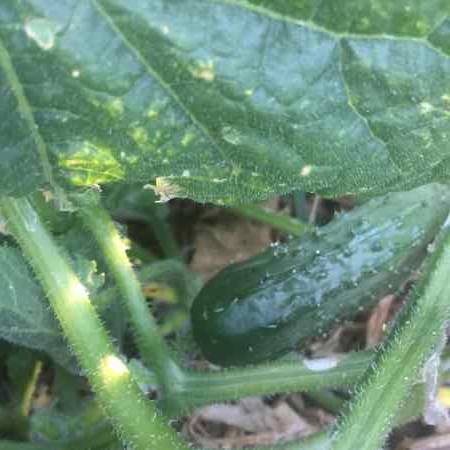 I gave my brother stick in a previous newsletter because he's not fond of Strawberries. Seriously. But if there's something he absolutely HATES - it's cucumber. He will sniff out a scrap in a salad at 100 paces. In fact, it's something of a family joke to try your best to sneak some onto his plate somehow (he always finds it). It's hard to believe we're from the same gene pool really. Luckily my sister and I are completely normal and enjoy cucumber. Heck - it's even trendy these days to stick a slice or two in a gin & tonic. (Try it - it's very refreshing!)
I gave my brother stick in a previous newsletter because he's not fond of Strawberries. Seriously. But if there's something he absolutely HATES - it's cucumber. He will sniff out a scrap in a salad at 100 paces. In fact, it's something of a family joke to try your best to sneak some onto his plate somehow (he always finds it). It's hard to believe we're from the same gene pool really. Luckily my sister and I are completely normal and enjoy cucumber. Heck - it's even trendy these days to stick a slice or two in a gin & tonic. (Try it - it's very refreshing!) Plants can be bearing crops in about 8 weeks. Some varieties tend to produce more male flowers at times - this is attributed to longer day length. If there's too many males forming, pick some off. Obviously female flowers are needed to form fruit. You can tell the difference by looking at the base of the flower - the shape will be different as there's a teeny potential fruit at the base of the female flower. Other varieties of cucumber form predominately female flowers - these have been adopted in cooler climates where they can be successfully grown in greenhouses; they are self fertile so don't need pollinators. This is known as parthenocarpy. Most hybrid seedlings and some non-hybrid varieties won't have the male/female flower issue - but unfortunately I haven't been able to research much on particular varieties. Once you DO have fruit set on your cucumber vines, pinching off new growth will encourage the plant to put its energy into the developing fruit. If you want the plant to pump out more fruit; pick young. Picking cucumbers young means they'll be sweeter - some varieties are quite bitter once they mature.
Plants can be bearing crops in about 8 weeks. Some varieties tend to produce more male flowers at times - this is attributed to longer day length. If there's too many males forming, pick some off. Obviously female flowers are needed to form fruit. You can tell the difference by looking at the base of the flower - the shape will be different as there's a teeny potential fruit at the base of the female flower. Other varieties of cucumber form predominately female flowers - these have been adopted in cooler climates where they can be successfully grown in greenhouses; they are self fertile so don't need pollinators. This is known as parthenocarpy. Most hybrid seedlings and some non-hybrid varieties won't have the male/female flower issue - but unfortunately I haven't been able to research much on particular varieties. Once you DO have fruit set on your cucumber vines, pinching off new growth will encourage the plant to put its energy into the developing fruit. If you want the plant to pump out more fruit; pick young. Picking cucumbers young means they'll be sweeter - some varieties are quite bitter once they mature.
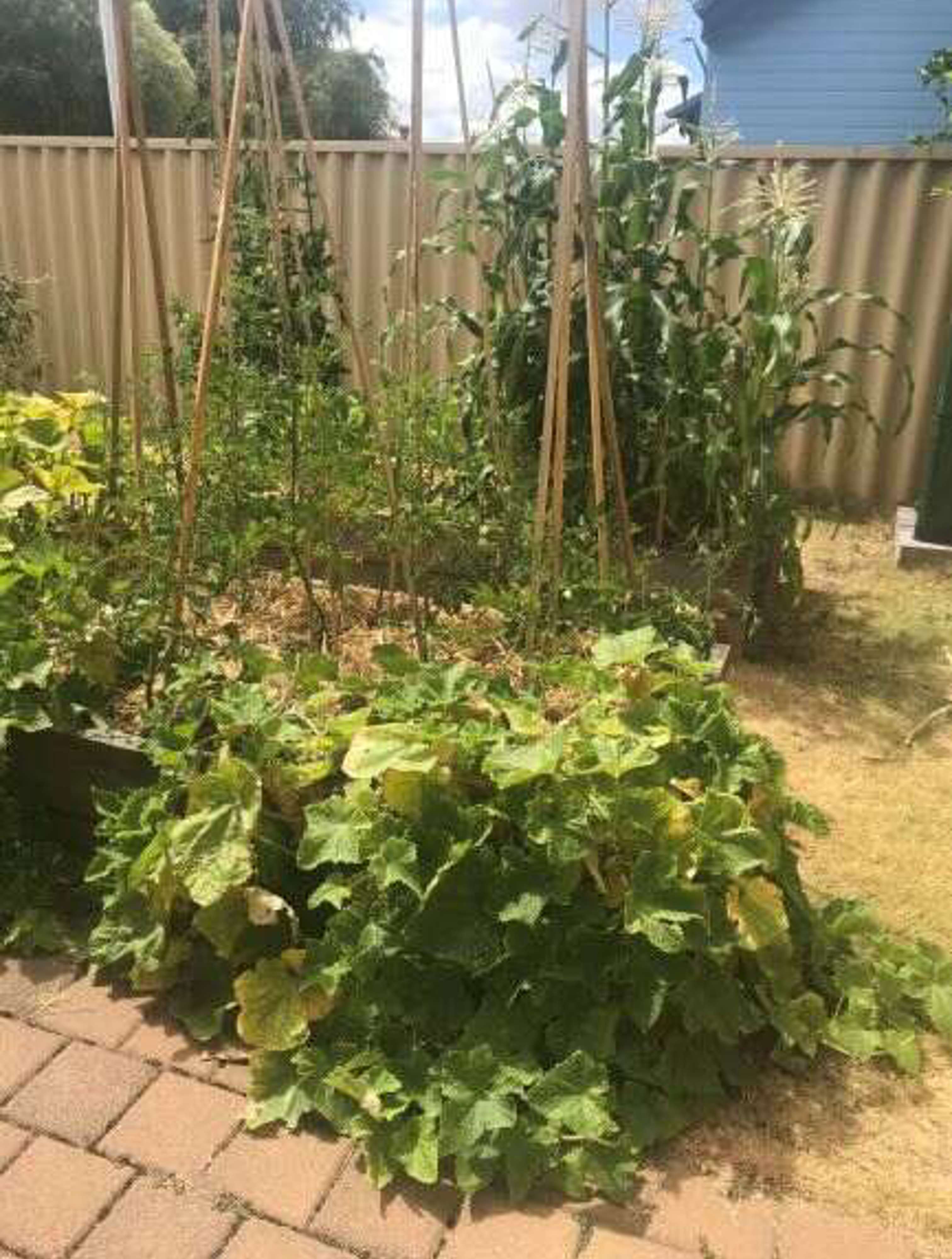
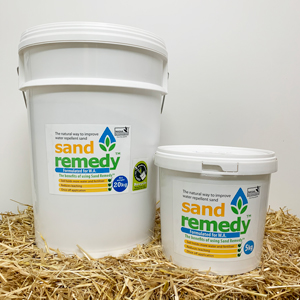 It is Certified Organic, and is a Waterwise Product - endorsed by the Water Corporation of WA, based on independent tests which proved plants treated with Sand Remedy coped better with less water.
It is Certified Organic, and is a Waterwise Product - endorsed by the Water Corporation of WA, based on independent tests which proved plants treated with Sand Remedy coped better with less water. Please support your local independent retailer who supports us! The specialist retailers listed here will be happy to give you gardening advice and help you with our products - please call to check what lines they carry as they can't stock all of our products.
Please support your local independent retailer who supports us! The specialist retailers listed here will be happy to give you gardening advice and help you with our products - please call to check what lines they carry as they can't stock all of our products. Ardess Nursery (Albany) 9842 9952Australind Landscaping Supplies 9796 1720
Ardess Nursery (Albany) 9842 9952Australind Landscaping Supplies 9796 1720






